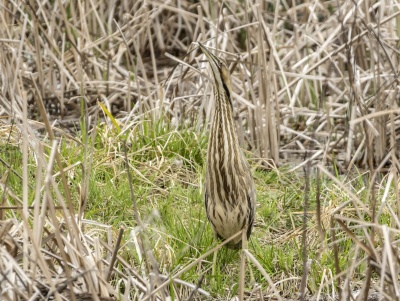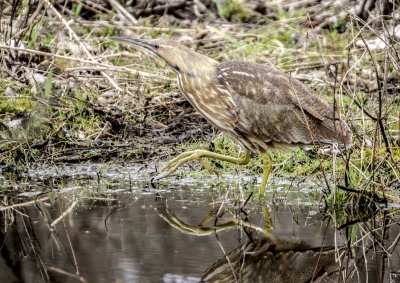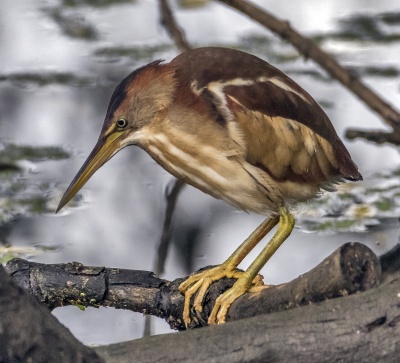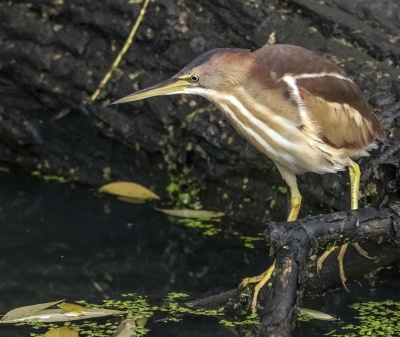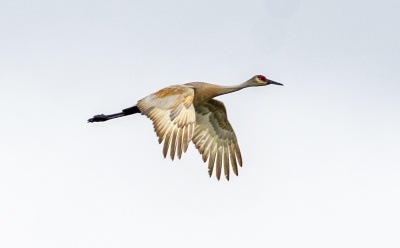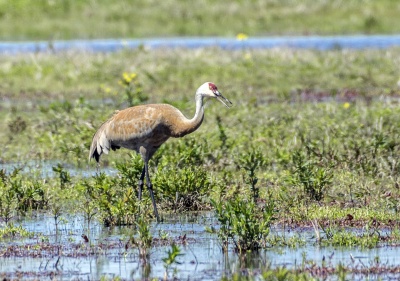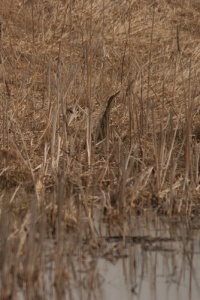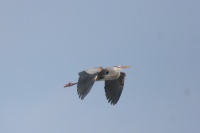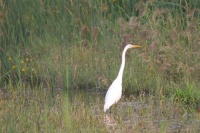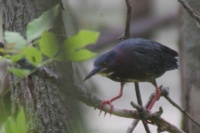Near Shore Birds
|
|
Not an official term, local "edge-water birds" is here meant to categorize Bitterns, Cranes, Egrets, and Herons.
Contents
Bitterns
American Bittern
(Botaurus lentiginosus)
American Bitterns are medium-sized herons with thick, compact bodies. They have shorter legs and thicker necks than typical herons and a slightly hunched posture. The daggerlike bill is long, straight, and sharply pointed. The wings are broad but the wingtips are somewhat pointed. American Bitterns are mostly warm brown, buff, and white. They are strongly streaked, especially on the neck, and they can be very hard to see against marsh vegetation. In flight the dark outer wings contrast sharply with the brown of the rest of the bird. Bitterns are stealth predators and typically stand motionless as they wait for prey to approach, or stalk it with barely perceptible motions. They adopt a classic pose when alarmed, with the beak pointing straight up, helping this streaky bird blend in with its reedy background. They tend to forage alone. Look for American Bitterns in shallow freshwater marshes, typically toward the margins and among reeds and other vegetation; they are rarely out in the open.
Least Bittern
(Ixobrychus exilis)
This diminutive heron is fairly common in its preferred wetland habitat, but secretive and easily overlooked. Found in marshes with a mix of open water and vegetation, often with cattails, phragmites, or lily pads. Usually seen perched motionless, straddling reeds at the edge of water or on a short dash flying just above the reeds. Its soft song, "coo-coo-coo," is heard at night. Attractive pattern of orange, black, and white is distinctive among herons. Female drabber than male. Feeds on small fish.
Cranes
Sandhill Crane
(Grus canadensis)
Sandhill Cranes are very large, tall birds with a long neck, long legs, and very broad wings. The bulky body tapers into a slender neck; the short tail is covered by drooping feathers that form a “bustle.” The head is small and the bill is straight and longer than the head.
These are slate gray birds, often with a rusty wash on the upperparts. Adults have a pale cheek and red skin on the crown. Their legs are black. Juveniles are gray and rusty brown, without the pale cheek or red crown. Sandhill Cranes forage for grains and invertebrates in prairies, grasslands, and marshes. They do not hunt in open water or hunch their necks the way herons do. Sandhill Cranes form extremely large flocks—into the tens of thousands—on their wintering grounds and during migration. They often migrate very high in the sky. Sandhill Cranes breed and forage in open prairies, grasslands, and wetlands. Outside of the breeding season, they often roost in deeper water of ponds or lakes, where they are safe from predators. Migratory birds most likely to be seen in and around the Iroquois National Wildlife Refuge. Otherwise seen in other areas as a flyover.
Egrets
- Great Egret (Ardea alba)
- Cattle Egret (Bubulcus ibis)
Herons
- Great Blue Heron (Ardea herodias)
- Green Heron (Butorides virescens)
- Black-Crowned Night-Heron (Nycticorax nycticorax)
